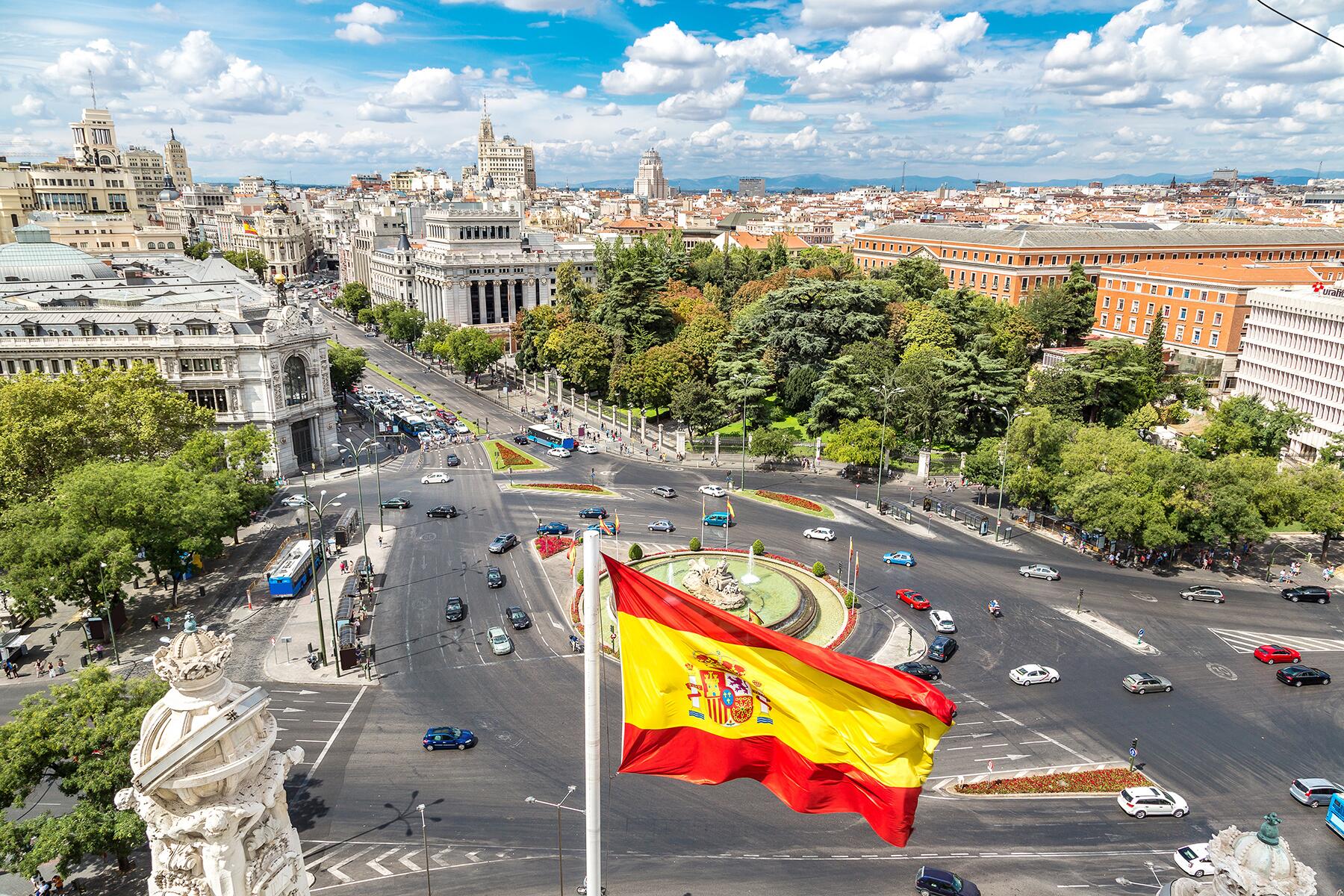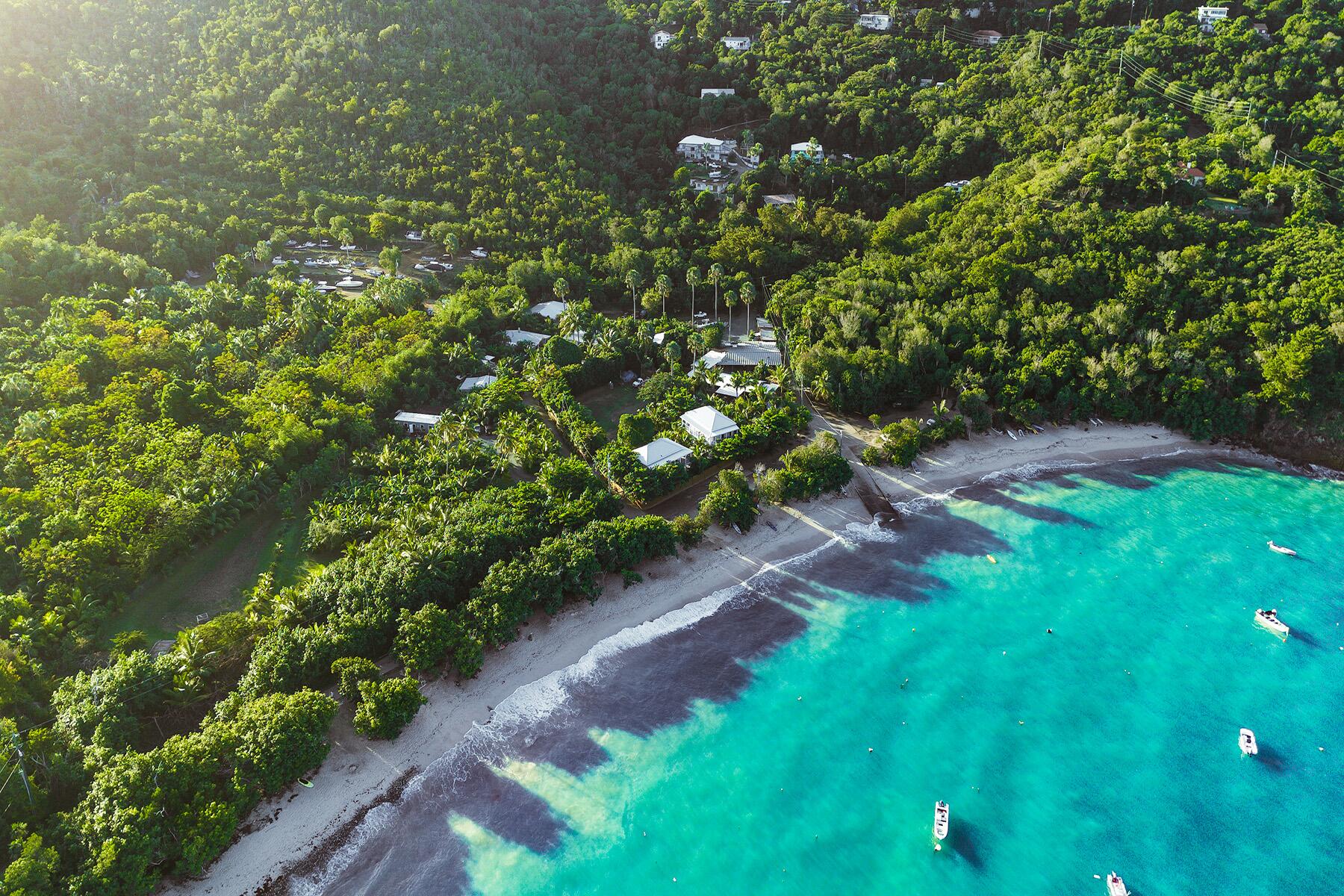“I’m lucky to be here.”
The island of St. Thomas—one of the three United States Virgin Islands—is a wondrous site to behold. The water, hot and gleaming azure under the Caribbean sun, surrounds the lush rolling hills dotted by painted roofs and the cascading reds of the flamboyant trees. The view is enough to stir palpable excitement among the crowd: As my plane landed at Cyril E. King Airport during a recent visit, my seat neighbor, who had donned a pineapple-patterned shirt, leaned over and told me that he was ready, body and mind, for a Painkiller—a rum-based drink famous across the Virgin Islands.
Just a short drive through the swaying palms and fruit trees that proliferate the island is enough to see that tourism and fishing are thriving on St. Thomas. Even during the wet season, enormous cruise ships dock almost daily in Charlotte Amalie; fish and crustaceans, caught by the local fishermen each morning and brought ashore, are served almost anywhere you turn. Per my driver’s recommendation, I settled my post-flight hunger at Chef John’s Island Flavor. “It’s a local spot,” he said with a laugh. “I get the salmon.” The orange chili salmon, served alongside two sides of your choice—in my case, a heap of seasoned rice and garlic mashed potatoes—was fresh, sweet, and succulent.
Recommended Fodor’s Video
Watching the hot lunch rush of the cruise port, I found it difficult to imagine the ruins that must have sprawled across the island in 2017, after Hurricanes Irma and Maria decimated St. Thomas and its sister island St. John. Irma ripped through the hillsides, downing electricity polls, trees, and buildings; within two weeks, Maria drowned whatever debris remained standing. Beachside accommodations—often the driving force of the island’s tourism industry—were reduced to rubble.
The process of rebuilding has been slow and onerous. Many commercial properties went through ownership changes and renovations that stretched for years on end, often prolonged by the onset of COVID-19 in 2020. The Frenchman’s Reef Resort on St. Thomas reopened some six years after the hurricanes; other less fortunate properties like the famed Caneel Bay Resort on St. John—once a destination for movie stars and presidents—still remain in ruins, mired in a bureaucratic battle over its redevelopment.
But now, the island’s foliage is immaculately green; the electrical poles have been reinstalled, the roofs have been rebuilt, and small businesses have reopened in full force.
Chef David Benjamin—or Chef Benji, as he is called—who owns and operates Blue 11 in Charlotte Amalie, opened his restaurant in 2019. Blue 11 focuses on tasting menus that heavily feature Caribbean produce and fresh catch. Starches like plantains and cassava make frequent appearances to accompany proteins like halibut, grouper, and tuna. The occasional red meat is a delicious surprise: the pan-seared lamb, served with coconut curried lentils and fried brussels sprouts, is cooked to spicy, delicate tenderness.
Seated at the Chef’s counter, I asked Chef Benji, a quiet, but charismatic presence in the kitchen, whether he had felt the effects of the hurricane and COVID-19. “People here are used to the hurricanes,” he said with a measured shrug. “Every five to six years, everything is wiped out and we start again.” COVID was indeed difficult: There were fixed financial costs that needed to be endured, on top of the already high prices for ingredients brought on by the island’s heavy reliance on food imports, but most importantly for the chef, creativity and the spirit of experimentation suffered.
Still, Blue 11’s menu is ever-changing. “I think change is good,” Chef Benji said. “But sometimes the locals don’t want things to change. Like the passion halibut and the seafood callaloo, they want these to stay.” And for good reason—the passion halibut features a cut of pan–seared halibut plated on the most delicate cassava foam and passionfruit butter; the foam—the first of its kind that I’ve encountered—is starchy, creamy, and nourishing, while the passion fruit seeds dotting the butter add a layer of tart flavor.
Towards the end of the 11-course tasting menu, I found myself comfortably satiated and abuzz with the warmth of the courses’ wine pairings. Moses, my server, asked if I would like a last drizzle of Riesling with the final course—a sugared doughnut with thick guava caramel and a scoop of espresso ice cream—and when I said yes, he squinted and asked, once again, if I was sure.
W
estward from the bustling Charlotte Amalie and Red Hook, St. Thomas becomes more remote and sparsely populated. On North Shore, Hull Bay collects fewer tourists than other beaches on the island. The beach is so close to the road that you can dip your toes in the hot sand in one minute and pad out into the main road the next; wild iguanas and chickens roam the sandy neighborhood shacks that serve burgers, tacos, and the punchiest piña coladas.
Bordering the waters of Hull Bay is the Hideaway estate, which lies beyond a small gate with an inconspicuous, hand-painted “Private Driveway” sign. For the lucky few that choose to lodge here, the gate opens into an intimate walkway reminiscent of a tropical paradise: the graveled path is lined by a dense foliage of swaying palms and flowering bushes, with scatterings of dripping pink bougainvillea and fiery orange hibiscus. There are six well-appointed cottages, two villas, a pool that changes color during the night, and an open-air gathering pavilion with lounge chairs, tables, and a coffee deck.

The estate also houses a two-acre farm that practices rich polyculture: trees that bear gineps, sugar apples, soursops, and mangoes grow next to each other in a striking, multilayered den of greens. Hiding beneath the bushes is the occasional iguana or a turtle. “We let them have the low-hanging fruits,” the property manager, Kasandra Noraas, told me with a smile. “But sometimes it’s a competition.”
The bounty is harvested and handed to Hideaway’s in-house Chef Risa Chu, who figures out a way to incorporate the items into her dishes. The abundance of mangoes from the farm’s mango tree requires extra care on her part not to waste them: they are frozen, preserved, and pickled, transforming into refreshing mango sorbet and popsicles or pickled mangoes that accompany spicy jerk ribs. Sorrel, a tangy edible flower, is dehydrated and used as garnish on cocktails.
Since the farm has a coffee plant, Chef Risa has even tried her hands at processing her own coffee. “It was hours of work for what essentially is a cup of coffee,” she laughed. But the small half-jar of coffee beans had the most complex, almost cream-like aroma. When I told her this, she smiled and wondered what she might do with it. “Maybe a coffee ice cream or tiramisu,” she said. Either way, it will be a delicacy for her guests.
The Hideaway’s current owner, Lee Steiner—a tall, suntanned St. Thomas native who regularly visits the pavilion’s coffee deck in the morning—acquired the property in early 2017. The renovations to revamp the space were stalled by the hurricanes, and later on, the onset of COVID-19, which brought on heavy financial burdens that they needed to slog through; then there was—and still is—the matter of adapting to the conditions of the island.
“As of now, the farm loses money,” Lee said. “It’s expensive to maintain. Water, for one, is very expensive because it uses a lot of electricity.” Still, the property stands behind the farm because it believes in a small-scale, sustainable approach to hospitality.
Lee also wants the property to bring in its own fish. On the North Shore and westward, the competition for fish is high because there is enough demand for them in the more populated southern and eastern ends of the island that the fishermen don’t feel the need to travel up. I asked if he’ll be hiring in-house fishermen; Lee shook his head. “I’ll just go out and fish,” he said matter-of-factly. He grew up fishing around the island, and it isn’t unusual for him or his friends to take out a boat and spear up a gigantic wahoo from the open waters. He told me that friends and family are the usual beneficiaries of these fishing trips—so why not his guests?

For visitors, chartering a boat and cruising around the islands is always a good idea. Certain alcoves with untainted, powder-soft sand or smaller keys can’t be accessed unless you’re on a boat. If you are a scuba diver, a boat is a necessity; snorkeling, though always possible near shore, is always better in deeper waters and might put you near opportunities to free-dive and tickle spiny lobsters out of their holes.
After a windy ride into the open blue waters, there is an immaculate joy in grounding the boat to a stop and jumping in for a quick, salty swim to cool the sun-warmed skin. Depending on the season, the islands are a haven for birdwatchers, with flocks of seabirds coasting across the waters. If you’re lucky and close enough to an area with dense foliage, you might be able to see a wild deer or a goat. From the easternmost part of St. Thomas, St. John’s Cruz Bay is just about 20 minutes away by boat. Traveling between the islands is routine; after a morning boat ride near Red Hook, I slipped off the boat at Cruz Bay—with a beach towel still slung across my shoulders—for an iced coffee and a light snack.
If boating isn’t an option, there is stand–up paddle boarding, kayaking, or surfing—all of which require less gear and time commitment. The guides are hospitable and warm, a reflection of the larger community that thrives on a sense of communal bond.
I found my paddle board instructor, Web, of St. Thomas Scuba and Snorkel Adventures, around five o’clock near Hull Bay, leaning on his sandy jeep and plucking on a guitar. A friend passed by, sighing of a sunburn from an earlier excursion out into the sea. “Where is your sun shirt?” he chided, then turned to me. “I’m a father and a grandfather, so I have to say this.”
We pushed our boards into the water and began our slow paddle around the shoreline. With great patience, Web taught me how to paddle around obstacles—in this case, the small boats bobbing near the shore.
During Irma and Maria, Web had been one of the lucky ones to have his house still somewhat intact, though he did lose his electricity and internet for several weeks. He told me that he considers the hurricanes “the Caribbean tax man”: you have to understand that, at some point, you’ll lose a lot of what you have, then start over again.
“It’s sort of like signing a prenup,” he chuckled over his tanned shoulder. The rippling waters began to sparkle against the setting sun, and I squinted my eyes to catch a better sight of him. “I declare that I understand the risk, in exchange of the fact that I get to do—” he gestured around the waters— “this every day. I’m lucky to be here.”
And during my brief trip down to the island, I found that this feeling of luck, the joy of being, was true. The bright blue water, the salt in my hair, and the pleasant hunger for a post-beach meal; the ability to doze on a swaying hammock in front of my cottage, my skin warmed and my body awash with the peaceful silence of the Hideaway; and most of all, the conversations that came as easily as they went—all of it made certain that I will be back again.



